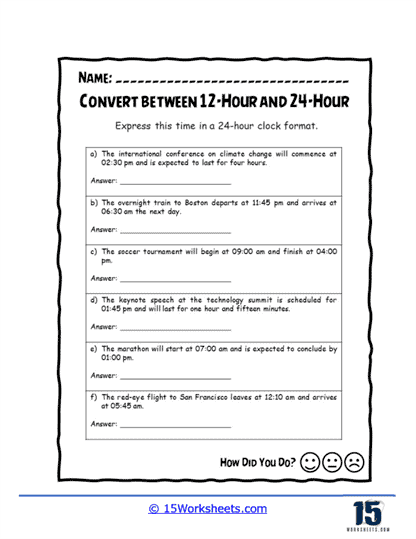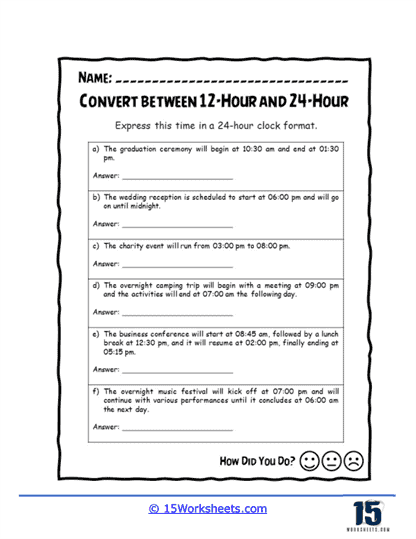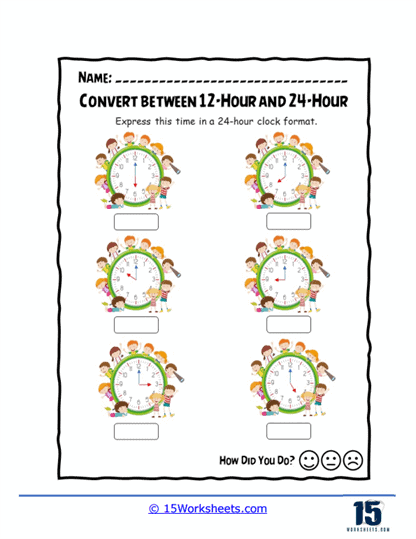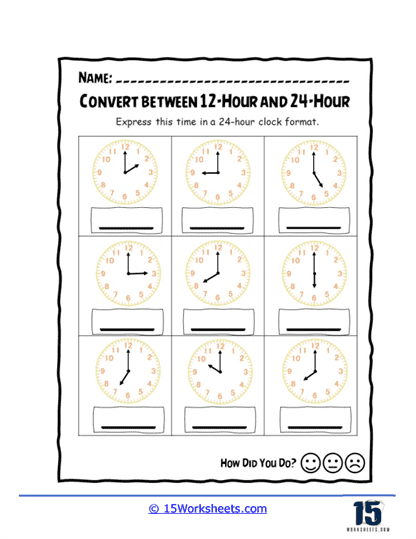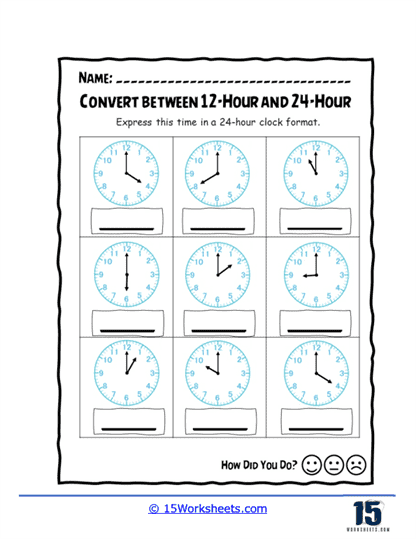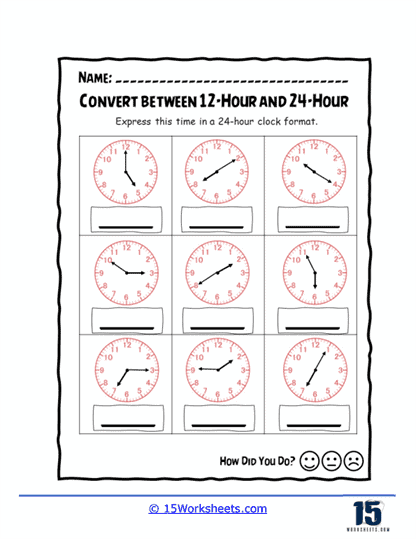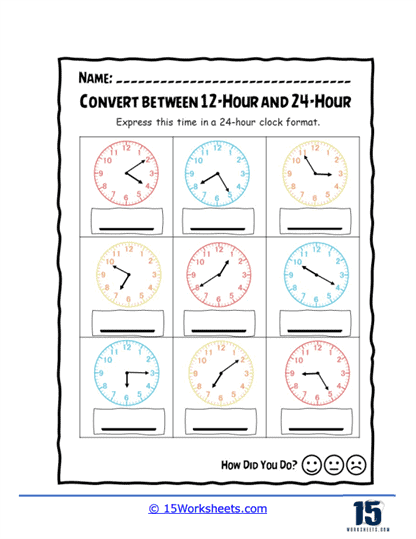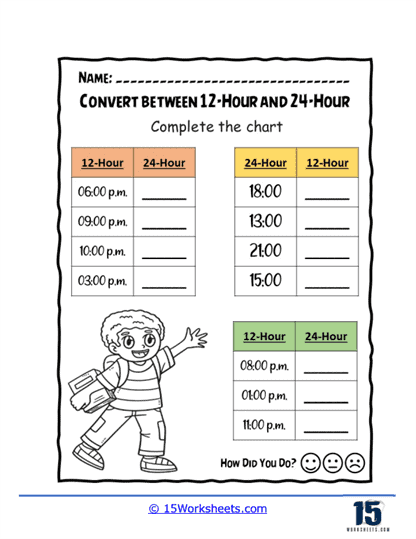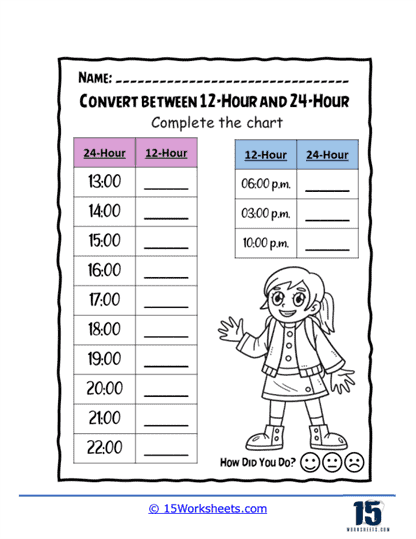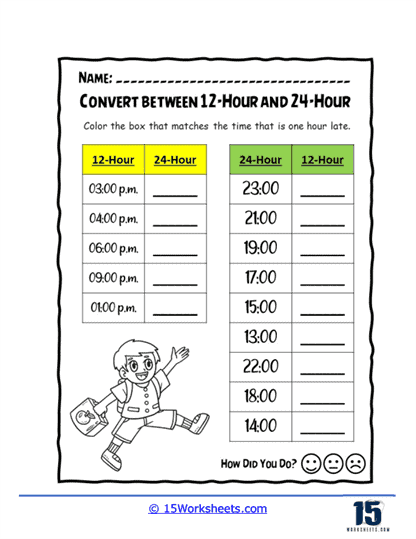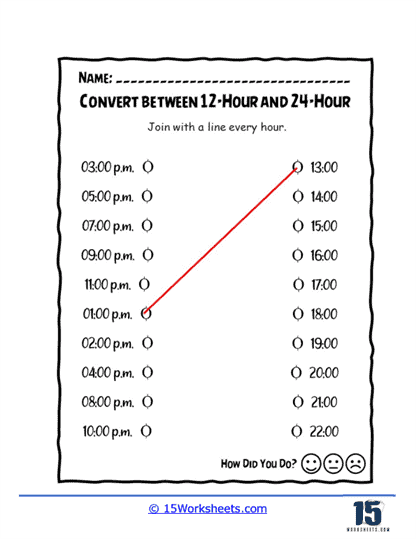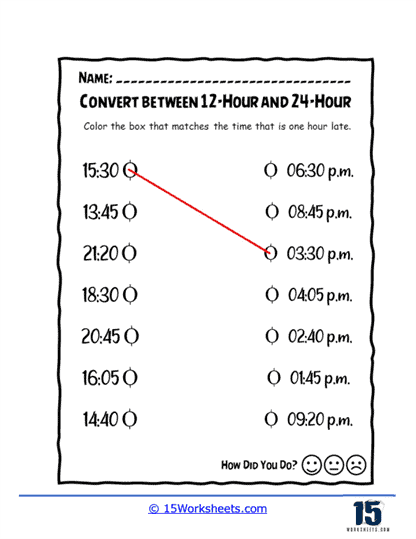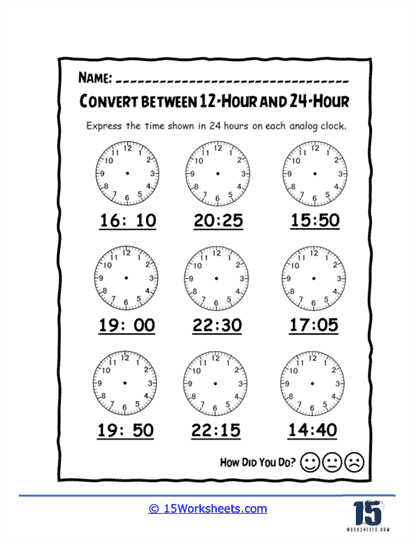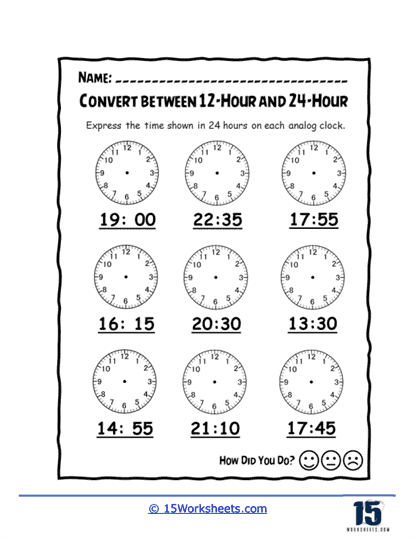Convert Between 12-Hour and 24-Hour Worksheets
About These 15 Worksheets
These worksheets will help students understand and practice the conversion of time between the two most commonly used time formats. The 12-hour clock, which divides the day into two periods of 12 hours each (AM and PM), is widely used in everyday life in many countries. On the other hand, the 24-hour clock, also known as military time, runs from 00:00 to 23:59 and is used in many professional and international contexts. These worksheets provide various exercises to help students master this essential skill, making them capable of interpreting and converting times accurately in both formats.
The Importance of Time Conversion Skills
Time conversion skills are fundamental for students because they play a crucial role in time management and daily scheduling. Understanding both time formats and knowing how to convert between them ensures that students can interpret timetables, schedules, and digital clocks accurately. This skill is especially important as students encounter various time formats in different contexts, such as in travel schedules, international communication, and professional environments. Moreover, mastering time conversion enhances students’ overall numeracy and cognitive skills, contributing to their academic and personal development.
Types of Exercises On These Worksheets
Simple Conversion Exercises – One of the most common exercises in time conversion worksheets involves simple conversion tasks. Students are presented with times in either the 12-hour or 24-hour format and are required to convert them to the other format. For example, converting 3:15 PM to 15:15 or 18:45 to 6:45 PM. These exercises help students get accustomed to the basic rules of conversion, such as adding 12 to the hour component for PM times in the 12-hour format to get the 24-hour equivalent and vice versa for converting from the 24-hour to the 12-hour format.
Clock Reading and Conversion – Another type of exercise involves reading times from analog clocks and converting them into the 24-hour format or vice versa. These tasks require students to first correctly interpret the time shown on the clock and then apply the conversion rules. This type of exercise not only reinforces time conversion skills but also improves students’ ability to read analog clocks, a skill that is becoming less common with the increasing prevalence of digital clocks.
Matching and Multiple Choice – Matching exercises and multiple-choice questions are also prevalent in these worksheets. Students may be given a list of times in one format and a corresponding list in another format, and they must match them correctly. Multiple-choice questions present a time in one format with several possible converted times, and students must select the correct one. These exercises provide a fun and engaging way for students to practice their time conversion skills and receive immediate feedback on their understanding.
Real-Life Scenarios – Real-life scenarios and word problems help students apply their time conversion skills in practical contexts. For instance, a problem might describe a flight schedule, asking students to convert departure and arrival times from the 24-hour format used by airlines to the 12-hour format they are more familiar with. These problems enhance critical thinking and show students the relevance of what they are learning by connecting it to real-world situations.
Elapsed Time Calculations – Some worksheets incorporate exercises that combine time conversion with elapsed time calculations. For example, students might be asked to determine the duration of an event given in one time format and then convert the start and end times into another format. This type of exercise reinforces both time conversion and elapsed time calculation skills, providing a more comprehensive understanding of time management.
The Benefits of These Worksheets
Enhancing Cognitive Skills – Time conversion worksheets enhance various cognitive skills, including arithmetic operations, critical thinking, and problem-solving. Converting times between formats involves adding and subtracting hours, understanding the concept of time, and applying logical reasoning. These skills are transferable to other areas of math and everyday life, making students more adept at handling complex tasks.
Practical Life Skills – Learning to convert between 12-hour and 24-hour formats equips students with practical life skills. These skills are useful in many everyday situations, such as reading schedules, planning activities, and understanding digital devices. Additionally, time conversion skills are crucial for travel, as transportation schedules often use the 24-hour format, and for professional contexts where precise timekeeping is essential.
Preparing for Advanced Studies – Mastering time conversion is a foundational skill that prepares students for more advanced studies in subjects like mathematics, science, and geography. Understanding time zones, calculating time differences, and interpreting scientific data often require proficiency in both time formats. Time conversion worksheets provide the practice needed to build a strong foundation for these advanced topics.
Real World Applications
Understanding how to convert between 12-hour and 24-hour time formats is highly useful in the real world for various reasons, primarily due to the widespread use of both formats in different contexts and regions. Mastery of this skill enhances communication, scheduling, and planning across multiple scenarios.
Many countries and industries use the 24-hour time format, also known as military time, for precision and to avoid ambiguity. For instance, transportation schedules for airlines, trains, and buses often use the 24-hour format to clearly indicate times and prevent misunderstandings. Knowing how to convert between formats ensures travelers can accurately interpret departure and arrival times, reducing the risk of missing connections or flights.
In professional settings, the ability to switch between time formats is crucial for effective communication, especially in global businesses. Many international companies and military operations standardize on the 24-hour clock to streamline operations and avoid confusion caused by time zone differences and the AM/PM designation. Being able to convert times allows employees to coordinate meetings and deadlines accurately with colleagues across different regions, ensuring seamless collaboration.
Healthcare is another field where understanding both time formats is essential. Medical professionals often use the 24-hour clock to record and communicate the timing of medication administrations, treatments, and shift changes. Accurate timekeeping is critical in this context to maintain patient safety and ensure that care is provided at the correct times.
Personal organization benefits from this skill. Many digital devices, such as smartphones, computers, and smart home systems, allow users to select their preferred time format. Being adept at converting between the two formats means that individuals can efficiently manage their schedules, set alarms, and program devices without confusion, regardless of the default settings.
Example Problem – Samantha has a school project due at 2:45 PM. She wants to convert this time into the 24-hour format. What time is 2:45 PM in the 24-hour format?
Step-by-Step Solution
1. Understand the Conversion Rule
– For PM times in the 12-hour format (from 1:00 PM to 11:59 PM), you need to add 12 to the hour part to convert it to the 24-hour format.
– For AM times (from 12:00 AM to 11:59 AM), the time remains the same except for 12:00 AM which becomes 00:00 in the 24-hour format.
2. Identify the Time to Convert
The given time is 2:45 PM.
3. Separate the Hours and Minutes
Hours: 2
Minutes: 45
4. Convert the Hours from PM to 24-hour Format
Since it is PM, add 12 to the hour part: 2 + 12 = 14.
5. Combine the Converted Hours and Minutes
The converted time is 14:45.
6. Answer – 2:45 PM in the 12-hour format is 14:45 in the 24-hour format.


